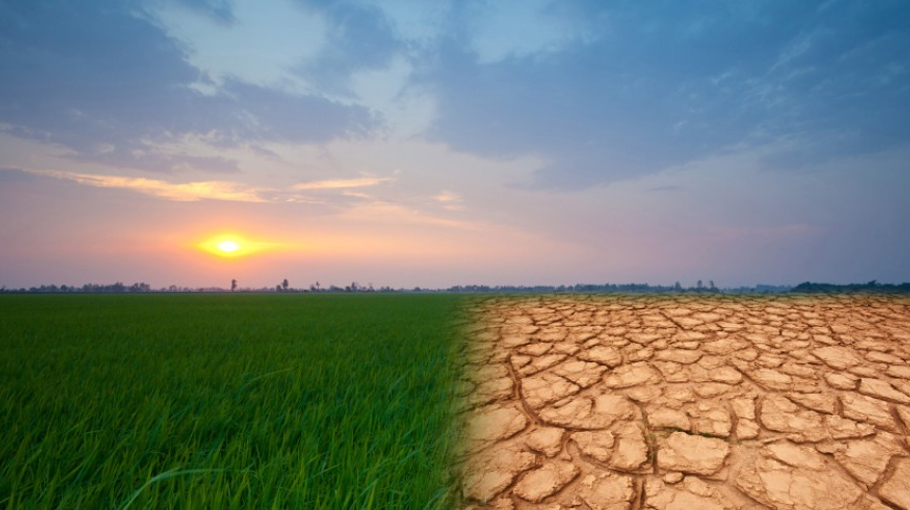A different monsoon
Drought in rainy season affects agriculture

It is now the rainy season, but such a dry and rainless rainy season has not been witnessed in the country in the last couple of decades. Bangladesh is now witnessing a different rainy season.
Devout Muslims and devotees of other communities, including the Hindu and some ethnic groups, in several parts of the country offered special prayers for rain.
Lack of rain during the peak monsoon period in July plays havoc on agriculture in the country. A vast part of cropland is currently dry and cracks have developed in cropland in many parts of the country, particularly in the northern districts, affecting the cultivation of Aman paddy, the second-largest paddy after Boro.
Meteorologists, environmentalists and experts on weather and climate change said that the drought situation is posing a threat to food security. They blamed man-made causes and the adverse impact of global climate change for the drought and the unpresented rainfall in Bangladesh.
Prof Dr. A.K.M. Saiful Islam, director at the Institute of Water and Flood Management of BUET, and Dr. Md. Khalequzzaman, a Bangladesh-born US professor at the Department of Geology & Physics of Lock Haven University; said that global warming has changed the type of weather and climate. Now when it rains, it rains much deeper. There will also be drought due to the impact of climate change.
The Rainy Season is the second season in Bangladesh. It consists of two months of the Bengali calendar-- Ashar and Srabon. The rainy season begins in June. Although the two months are rainy season, it rains till the middle of the month of Bhadra in the country.
The highest rainfall in Bangladesh is recorded in July as well as the last 15 days of Bengali month of Ashar and first 15 days of Srabon. However, there is no sign of rain although half of Srabon is over and July ended. The country experiences temperatures in the full monsoon season higher than in summer as there is no rain this time.
The country has so far witnessed 66 per cent lesser rainfall this July, according to the Bangladesh Meteorological Department (BMD).
The weather has been hot for the last few days. The country is experiencing scattered clouds in the sky like autumn and winter and intense heat at the same time. As a result, the countrymen have to bear the pain of scorching heat even during the rainy season.
Meteorologists and experts on weather and climate change said that global climate change has affected Bangladesh. The reason for this lack of rain is man-made. Even the communication of the country’s rains with other countries is also a major reason for this disruption.
Dr Md Abul Kalam Mallik, meteorologist at BMD; said that such a rainless monsoon has not been seen in Bangladesh in the last two decades. More rainfall is recorded every year usually in July. If the calculation of rainfall from 2000 to 2022 is taken into consideration, it has to be said that 66 per cent rain has decreased so far this year. This is definitely an exceptional case. There is a slight difference all over the world.
He said, “We had mentioned the possibility of rain in July in the long-term forecast. But that has become much less. The rainy season has not been like a monsoon. If we talk about Dhaka, it is raining regularly. But we have a record of 11 consecutive days of rain here in this monsoon. It didn’t look like that this time. Next week will be the same. There will be light rain, no chance of heavy rain.”
Agriculture suffers the most damage due to intense sun for several weeks. The arable land in several parts of the country, particularly in northern parts of Bangladesh, has been torn apart. At this time in other years, Aman seedlings are planted in wet land, but this time there is no water in the land. Against this backdrop, a crisis in country’s northern agriculture is apprehended.
Meanwhile, many people are suffering from various diseases due to the heat-wave. Physicians said that many people are coming to them with symptoms of fever and body aches due to the heat even in the monsoon. Bodies of many people are being dehydrated due to extreme heat. Fever, cold and cough increase usually after the monsoon and at the end of autumn. This time there are more such patients than ever. About 80 percent of the children coming to the hospital for treatment are attacked with fever, cold and cough problems.
Adnan Ahmed, a resident of Modhubagh area at Moghbazar in the capital, has been suffering from coughing problem with fever and cold for some days. His wife and child also have fever. His doctor gave two tests- Covid-19 and dengue. Both are negative. The fever now gets better, but the accumulation of phlegm in the chest due to cold does not get better. As per doctor’s advice, now there is no treatment except more liquid diet and fruits. Doctor thinks that this is the result of heat.
Dr Rakibul Islam, a child specialist in Dhaka, said that children should be extra careful during hot. They suffer more because they cannot manage their cold themselves.
According to the BMD, the heat-wave has been flowing over some districts, including Dhaka, Rajshahi, Rangpur, Sylhet, Jashore and Kushtia, for the last several days. Heavy rain is required. However, there is no sign of heavy rainfall in any part of the country or there is no chance of light or moderate rains. “We cannot predict any possibility of continuous rain,” said meteorologist Abul Kalam Mallik.
The country is experiencing the drought just days after the northeastern region of the country witnessed record-breaking flooding. The heaviest flooding devastated Sylhet region and some other parts of the country in June. The northeastern region saw 56 to 68 per cent higher rainfall in the month and other regions 30 to 48 per cent lesser experiencing drought during this peak Aman seedling and Aus growing periods.
However, the Sylhet region is also experiencing drought at the time. Both the drought and flood, which hits just before the drought, hit hard rice and other crop farming for such deviation in this Kharif period that produces 45 per cent of rice and 40 per cent of vegetables.
Heavy floods in June severely affected Aman farming in 11 districts, according to the Department of Agricultural Extension (DAE). On the other hand, drought in June and July in most parts of the country also hits farmers who are going for supplementary irrigation this monsoon.
The heat weather following flooding in some parts of the country had hurt the previous two rice crops -- Boro and Aush. The hot weather has created worries among farmers.
A farmer in Rajshai district said that they have been passing their days looking at the sky for rains. He had prepared his seedbed to plant Aman, but he could not transplant the seedlings for the drought-like situation.
Farmers normally start transplanting Aman at the beginning of Srabon. The Bengali month begins on July 16. Aman crop meets 38 per cent of the national rice demand.
Abdul Hye Ranju, a writer on nature and climate chang, said that nature has changed mainly due to the impact of climate change. The entire world, including Bangladesh, is warming with excessive carbon dioxide consumption.
He said that it is now the rainy season in Bangladesh and agricultural land is supposed to be wet with monsoon rains by now. Farmers plant Aman seedlings at the time. But there is no rain now. As a result, farmers are not able to plant Aman seedlings. On the other hand, the cropland has been torn apart in different parts of the country.
The situation in the northern districts is very fragile. Barind Tract of Rajshahi region receives very little rainfall this year. It was raining in Rangpur, Dinajpur, Lalmonirhat and Kurigram for more or less 5/6 consecutive months, while Rajshahi and Natore areas did not experience any rain. As a result, the dependence on groundwater has increased to meet the water demand. For this reason, the groundwater level is going down.
In the Barind, water was not available except 5/7 hundred feet deep from long ago. Now the water level in Natore, Naogaon, Bogura and Rangpur regions has gone down so much that the farmers have to dig the soil up to 10/15 feet deep and install irrigation machines to extract the water. As a result, the level of arsenic in water has increased in some places in these areas. People are suffering from various diseases by drinking the water, said Abdul Hye Ranju.
A special prayer was held in Sylhet to get rid of extreme heat and the damage of recent floods. Sylhet City Corporation arranged the Istiska prayers at Shahi Eidgah in the city last week. Thousands of people also offered Istiska prayers for rain in Rangpur on July 18. Such prayers were also arranged in Joypurhat and some other places in the country.
On July 15, local people of Muslim community in Dinajpur offered special prayers for rain. They offered the prayers at the central Eidgah ground of Setabganj municipality of Bochaganj upazila.
On the other hand, people of Hindu community organised a frog wedding in the district. The frog wedding ceremony took place at Hira Bagan Rakshakali Mandir in Rajbari Chatter according to Hindu rituals.
The organisers of the frog wedding said that July 15 was the last day of Bengali month Ashar. But there is no rain. There is no water in the land. Aman seedlings cannot be planted due to lack of water. Against this backdrop, the frog wedding ceremony was arranged to get rid of the lack of rain and drought, said Narayan Chandra Jhan, the priest of Hira Bagan Rakshakali Mandir in Dinajpur.
Such a frog wedding ceremony was also arranged by the people of Hindu community at Khedapara village at Kaliganj upazila in Jhenaidah on July 21 with the hope of rain.


